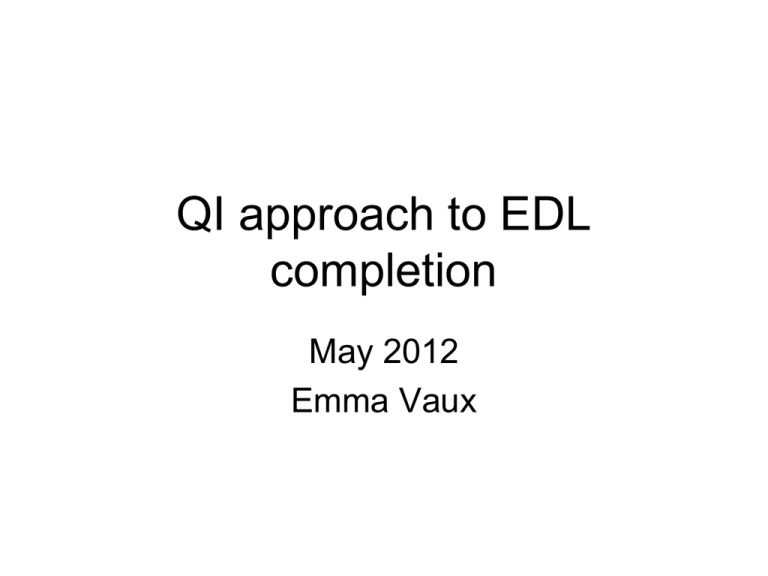QI approach using driver diagrams
advertisement

QI approach to EDL completion May 2012 Emma Vaux Objectives • To identify key elements which drive EDL completion and content • To identify changes likely to impact on EDL completion and content The Improvement Guide, API What are we trying to accomplish? 1. Reduce the incidence of HAP by 50% over a six month period in 8 adult wards 2. Engage junior doctors, nurses and AHPs in quality improvement methodology How do we know a change is an improvement? 1. Incidence of HAP has been reduced on these wards 2. Embed new skills in QI methodology and demonstrate learning and development What change can we make that will result in an improvement? 1. Implement interventions from Saving Lives 2006 ventilator associated care bundle relevant to HAP 2. Use QI methodology at the frontline to make a visible change Driver Diagrams, a useful tool to help us understand the system and the messiness of life. PURPOSE OF DRIVER DIAGRAMS • Helps you to set priorities • Identifying the drivers that will have the biggest impact • Help organize your theories about what it takes to achieve improvement • Leads you to the third question in the model for improvement – What changes can you make that will result in improvement? • Helps you then understand your current level of performance on these drivers • Essentially is a set of concepts – to make these concepts operational you will need to identify measures that indicate progress towards aim(s) PRIMARY DRIVERS • 2 or 3 key elements that will deliver the goal or aim SECONDARY DRIVERS • Processes, cultural norms or structures that contribute to the primary drivers • Changing these may lead to improvement • Differ in relative impact on outcome • Should be necessary and sufficient to achieve goal – or why bother? Step 1 AIM • Set AIM • SMART • Example “across the Trust, to increase the proportion of completed EDLs within 24 hours prior to discharge by 75% by October 2011 so that we can increase the number of patients discharged by 10am on their discharge date, and increase our reimbursement for their admission” Step 2 • Primary drivers • Directly contribute towards our aim • Key things need to deliver to achieve aim • They are high level • Ask yourself: – If I made an improvement in this driver what would it achieve? (Would it move you closer to your aim?) – If I did all these things (all primary drivers) could anything else stop me achieving my aim? If so, you may have missed another primary driver. – You are likely to have two or four primary drivers Primary drivers AIM: Increase number of EDLs completed within 24 hours of discharge to enable effective discharge planning Discharge decision EDL Completion Pharmacy Content Step 3 • Secondary drivers are the factors contribute to the key elements • These are the areas where you can start to identify actions, interventions or change ideas that will begin to affect your primary drivers and move you towards your aim • If find it hard to understand the drivers or to think what other drivers there may be, try looking at it the other way around: – If we don’t have certain things in place, what goes wrong? Primary Drivers Discharge decision AIM: Increase number of EDLs completed within 24 hours of discharge to enable effective discharge planning EDL completion Pharmacy Content Secondary Drivers •Ward round times •Ward round structure •Consultant-led decision making •Elective admission- predictable •Emergency admission •Junior doctor availability •Opportunities for completion •Time needed for completion •TTO completion •Opening times •Ward pharmacist •portering •Information to GP •Mandatory •format •coding Step 4 • Relationship arrows • These indicate how the drivers affect one another • A secondary driver may impact on more than one primary driver • This starts to highlight the cause and effect relationships and where there may be greatest gain from improvement efforts Primary Drivers Discharge decision AIM: Increase number of EDLs completed within 24 hours of discharge to enable effective discharge planning EDL completion Pharmacy Content Secondary Drivers •Ward round times •Ward round structure •Consultant-led decision making •Elective admission- predictable •Emergency admission •Junior doctor availability •Opportunities for completion •Time needed for completion •TTO completion •Opening times •Ward pharmacist •portering •Information to GP •Mandatory •format •coding Step 5 • Priorities for action – Once you have identified your drivers you can start to identify priorities for action, interventions and change ideas – Where can you most influence your aim? Step 6 • Agree measures – You can then start to identify relevant, appropriate measures that fit each driver to show progress towards your overall aim – It may be difficult or take time to show progress in your overall aim. These measures will help demonstrate what progress is being made and can help others stay interested and motivated in your project. Primary Drivers Discharge decision AIM: Increase number of EDLs completed within 24 hours of discharge to enable effective discharge planning EDL completion Pharmacy Content Secondary Drivers Step down ward •Ward round times Sick, •Ward round structure discharges, rest•Consultant-led decision making •Elective admission- predictable Nurse-led discharge •Emergency admission •Junior doctor time •Opportunities for completion Anticipated discharge •TTO completion times 7•Opening day week working •Ward pharmacist •portering •Information to GP •Mandatory •format Pocket card guidance •coding Driver Diagrams: Summary – Help identify the essential factors – Help you prioritise your improvement efforts – Help you define meaningful measures – Help break down a big task into manageable steps – Help communicate your aim and why you are doing certain things – Work well when you involve others in developing and sharing them Decision time! • Overall aims • QI projects to achieve this Process mapping template Improvement Idea / PDSA / Action Person Target Responsible Date OVERCOMING BARRIERS - FORCE FIELD ANALYSIS What is it? Force Field Analysis is a QI tool designed to identify driving (positive) and restraining (negative) forces that support or work against the solution of an issue or problem. When the driving and restraining forces are identified, steps can be taken to reinforce the driving forces and reduce the restraining forces What does the Force Field do? Allows comparisons of the “positives” and “negatives” of a situation Enables easy comparisons Forces people to think together about all the aspects of making the desired change a permanent one Encourages people to agree about the relative priority of factors on each side of an issue Supports the honest and open reflection on the underlying root causes of a problem and ways to break down barriers FORCE FIELD ANALYSIS WORKSHEET Driving Forces (+) Restraining Forces (-) ISSUE OR PROJECT: ______________________________________ Actions to reduce the Restraining Forces: • • •



